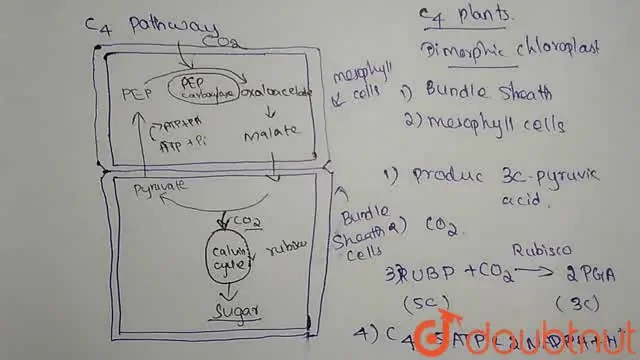Why do plants such as maize and sugarcane have dimorphic chloroplasts. Explain photosynthetic carbon cycle in such plants? Solution in Tamil
Video Solution
Text Solution
Maize and sugarcane have dimorphic chloroplasts. They have C4 or Hatch and slack pathway for carbon di oxide fixation.
Dimorphic chloroplast: Bundle sheath chloroplast are larger and thylakoids are not arranged in granum. Mesophyll chloroplast are smaller and thylakoilds are arranged in granum.
1 C4 pathway is completed in two phases , first phase take place in stroma of mesophyll cells , where the CO2 acceptor molecule is 3-Carbon compound , Phospho Enol Pyruvate (PEP) to form 4- Carbon Oxalo Acetic Acid (O AA) .
2 The first product is a 4 - Carbon and so it named as C4 cycle . Oxalo Acetic Acid is a dicarboxylic acid and hence this cycle is also known as Dicarboxylic Acid Pathway .

Stage : I Mesophyll Cells
Stage II Bundle sheath cells :
1 Malic acid undergoes decarboxylation and produces a 3 carbon compound Pyruvic acid released to the phloem .
2 The released CO2 combines with RUBP and follows the Calvin Cycle and finally sugar is released to the phloem .
3 Pyruvic acid is transported to the mesophyll cells . RUBP(5C)+CO2Rubisco−−−−→2PGA(3C)
4 Carbon dioxide fixation takes place in two places in mesophyll and another in bundle shealth cell (Di Carboxylation Pathway) .
5 It is the adaptation of Tropical and Sub Tropical plants growing in warm and dry condition.
6 Fixation of CO2 with minimal loss is due to photorespiration. C4 plants 5 ATP and 2 NADPH+H+ to fix one molecule of CO2
|
Updated on:21/07/2023
Similar Questions
ಕ್ಲೋರೋಪ್ಲಾಸ್ಟ್ಗಳು ಸಸ್ಯಜೀವಕೋಶಗಳಲ್ಲಿ ಮಾತ್ರ ಏಕೆ ಕಂಡುಬರುತ್ತವೆ ಎಂದು ವಿವರಿಸಿ.
03:46View SolutionChloroplasts show dimorphism in C4 plants.
01:37View SolutionKranz' anatomy and dimorphic chloroplasts are present in (a) Sugarcane and maize (b) Cotton and mustard (c) Pea and Euphorbia (d) Mango and Opuntia
01:35View SolutionWhich plant shows chloroplast dimorphism?
View SolutionDiscuss do all the plant cells have chloroplasts ?
02:18View SolutionWhich plant shows chloroplast dimorphism
01:24View SolutionExplain why chloroplasts are found only in plant cells?
02:04View SolutionExplain why choroplasts are found only in plant cells?
01:48View Solution


